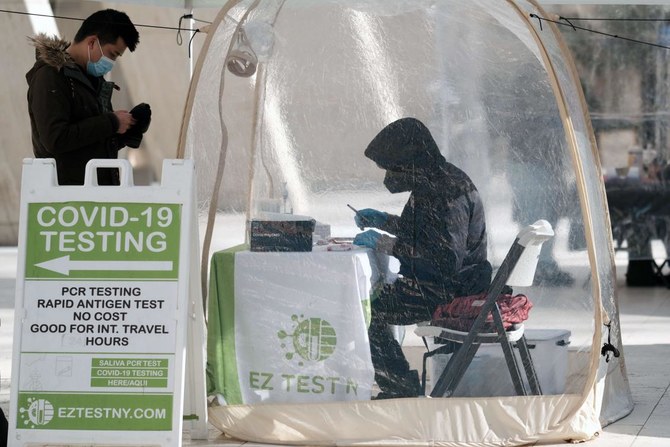PHOENIX: Arizona Gov. Doug Ducey sued the Biden administration on Friday over its demand that the state stop sending millions in federal COVID-19 relief money to schools that don’t have mask requirements or that close due to COVID-19 outbreaks.
The lawsuit filed in federal court in Phoenix comes a week after the US Treasury Department demanded that Ducey either restructure the $163 million program to eliminate restrictions it says undermine public health recommendations or face a repayment demand.
The Treasury Department also wants changes to a $10 million program Ducey created that gives private school tuition money to parents if their children’s schools have mask mandates.
Ducey’s lawsuit said the Treasury Department created restrictions on spending the money Arizona receives under President Joe Biden’s American Rescue Plan Act on its own and without legal authority. It asks a court to declare that the Treasury Department’s rules are illegal and permanently block enforcement and any demands that it pay back the $173 million it is spending on the two programs.
“Nothing in that underlying statute authorizes Treasury to condition the use of (ARPA) monies on following measures that, in the view of Treasury, stop the spread of COVID-19,” the lawsuit says. “If Congress had truly intended to give Treasury the power to dictate public health edicts to the States, and recoup or withhold (monies) ... it would have spoken clearly on the matter. It did not.”
The Centers for Disease Control and Prevention recommends universal mask-wearing in school settings to prevent the spread of COVID-19.
“By discouraging families and school districts from following this guidance, the conditions referenced above undermine efforts to stop the spread of COVID-19,” the Treasury Department wrote in last week’s letter.
The Treasury Department started demanding that Ducey change the programs in October. It was part of a concerted effort to force Arizona and some other Republican-led states that have opposed mask mandates or were using pandemic funding to advance their own agendas to end those practices.
Ducey rejected Treasury’s request the following month, and last week the Biden administration followed up with a formal demand that it cease using the money for the disputed programs or face either repayment demands or withholding of additional money it is set to receive under Biden’s COVID relief bill.
Friday’s lawsuit said the Treasury Department initially recognized that states have “broad latitude to choose whether and how to use the (money) to respond to and address the negative economic impact” of COVID-19. But then it changed course, and created the new rules, the suit said.
The Treasury Department did not immediately respond to a request for comment on the new lawsuit.
At issue are two state programs the Republican governor created last summer meant to help schools and students.
Arizona’s Education Plus-Up Grant Program provides $163 million in funding to schools in higher-income areas that received less than $1,800 per student in federal virus aid. Districts that require face coverings or that have closed due to virus outbreaks are ineligible.
Another called the COVID-19 Educational Recovery Benefit Program provides for up to $7,000 for parents if their child’s school requires face coverings or quarantines after exposure. It lets parents use the money for private school tuition or other education costs and its design mirrors the state’s existing school voucher program.
In a letter sent last week, the Treasury Department warned that the state has 60 days to remove the anti-masking provisions before the federal government moves to recover the relief money, and it threatened to withhold the next tranche of aid as well.
Ducey created the programs in part to up the pressure on school districts that had mask mandates or other COVID-19 restrictions, saying they were hurting children and parents who had endured more than a year of school shutdowns, remote learning and other restrictions. Provisions in the state budget that barred school mask mandates statewide were later thrown out by the Arizona Supreme Court because they were improperly adopted, but Ducey did not change the programs.
“Safety recommendations are welcomed and encouraged — mandates that place more stress on students and families aren’t,” Ducey said in August. “These grants acknowledge efforts by schools and educators that are following state laws and keeping their classroom doors open for Arizona’s students.”
Arizona has received about half of the $4.2 billion awarded to it under the 2021 coronavirus relief bill, and the Treasury Department said it may withhold payments if Ducey failed to comply with its demands.
Arizona sues Biden to keep school anti-mask rules
https://arab.news/jddc6
Arizona sues Biden to keep school anti-mask rules

- Ducey's lawsuit said the Treasury Department created restrictions on spending the money Arizona receives under President Joe Biden's American Rescue Plan Act
- The Centers for Disease Control and Prevention recommends universal mask-wearing in school settings to prevent the spread of COVID-19
Turkiye and Germany in spicy feud over doner kebab

- The humble doner has its origins in Turkiye but is also beloved in Germany after being introduced there by Turkish migrants
BERLIN: A spicy row has erupted between Turkiye and Germany over what constitutes a doner kebab, with Berlin objecting to a Turkish push for protected status for the iconic snack.
The humble doner, made with thinly sliced meat cooked on a vertical rotisserie, has its origins in Turkiye but is also beloved in Germany after being introduced there by Turkish migrants.
In April, the International Doner Federation (Udofed), based in Turkiye, filed an application to the European Commission to grant the doner kebab Traditional Speciality Guaranteed (TSG) status.
From the exact meat and spices to the thickness of the knife used to slice the meat, Udofed wants the definition of the doner to adhere to a strict list of criteria.
If successful, the application would bar businesses in the European Union from using the name doner kebab unless it met the criteria, giving it the same protected status as Italy’s bufala mozzarella or Spain’s Serrano ham.
In its application, Udofed hails the doner’s origins during the Ottoman Empire, citing a recipe found in manuscripts dating from 1546.
But that has sparked an uproar in Germany, where the doner has become an emblem of the country’s large Turkish community, descended from “guest workers” invited under a massive economic program in the 1960s and 70s.
The German capital even claims the doner kebab to be “a Berlin invention.”
“It happened in Berlin: Legend has it, Kadir Nurman was the first to put the meat in flatbread in 1972 and invented the version of doner that is so beloved in Germany,” according to the city’s website.
“The doner belongs to Germany. Everyone should be allowed to decide for themselves how it is prepared and eaten here. There is no need for any guidelines from Ankara,” said Agriculture Minister Cem Ozdemir, whose parents migrated from Turkiye.
Germany’s agriculture ministry viewed Turkiye’s application “with astonishment,” a spokesman said.
If this “imprecise” and “contradictory” proposal is accepted by the commission, “the economic consequences for the German gastronomic sector would be enormous,” the spokesman said.
The DEHOGA hotel and catering union also warned of a “lack of clarity and transparency,” “difficulties with legal definitions” and “a raft of future disputes.”
The German government lodged an objection to the Turkish application just ahead of the European deadline on Wednesday.
In Berlin, where the doner has long surpassed the sausage as the convenience snack of choice, Birol Yagci is concerned that the Turkish version only allows beef, lamb or chicken.
“Here it’s different. The traditional recipe is made with veal,” the chef at a Turkish restaurant in the city’s Kreuzberg district said.
Behind him, two columns of meat glisten on their spits, one ironically made from turkey — the bird — which would also not be allowed under the new definition.
“People eat doners all over the world. Turkiye can’t just dictate to others what they should do,” said the 50-year-old.
“My customers won’t want to eat lamb. It has a very particular taste,” said Arif Keles, 39, owner of a doner kiosk, whose customers include Germany’s national football team.
Keles too said he would sooner charge the name of his products than alter his recipes.
“My customers know what they’re eating, so as long as the quality is there it doesn’t matter what you call it,” he said.
Germany accounts for two-thirds of doner kebab sales in Europe with the market worth 2.4 billion euros ($2.6 billion) a year, according to the Association of Doner Manufacturers in Europe (ATDID).
In April, German President Frank-Walter Steinmeier even took Keles with him on a visit to Turkiye as a symbol of the close ties between the two countries.
Keles arrived to serve his wares at an official reception armed with a huge spit of veal, much to the “curiosity” of his guests.
“In Turkiye, doner is eaten on a plate. I served it Berlin-style, on bread with sauce, and they loved it,” said the chef, whose grandfather emigrated from Turkiye to Germany.
But the European Commission must now decide whether doner diversity will win the day, according to the institution’s agriculture spokesman Olof Gill.
If the objection to the Turkish application is found to be admissible, the two parties will have a maximum of six months to reach a compromise, he said.
NASA telescope spots a super Jupiter that takes more than a century to go around its star

- The planet is roughly the same diameter as Jupiter, but with six times the mass
- One big difference: It takes this planet more than a century, possibly as long as 250 years, to go around its star
CAPE CANAVERAL, Florida: A super Jupiter has been spotted around a neighboring star by the Webb Space Telescope — and it has a super orbit.
The planet is roughly the same diameter as Jupiter, but with six times the mass. Its atmosphere is also rich in hydrogen like Jupiter’s.
One big difference: It takes this planet more than a century, possibly as long as 250 years, to go around its star. It’s 15 times the distance from its star than Earth is to the sun.
Scientists had long suspected a big planet circled this star 12 light-years away, but not this massive or far from its star. A light-year is 5.8 trillion miles. These new observations show the planet orbits the star Epsilon Indi A, part of a three-star system.
An international team led by Max Planck Institute for Astronomy’s Elisabeth Matthews in Germany collected the images last year and published the findings Wednesday in the journal Nature.
Astronomers directly observed the incredibly old and cold gas giant — a rare and tricky feat — by masking the star through use of a special shading device on Webb. By blocking the starlight, the planet stood out as a pinpoint of infrared light.
The planet and star clock in at 3.5 billion years old, 1 billion years younger than our own solar system, but still considered old and brighter than expected, according to Matthews.
The star is so close and bright to our own solar system that it’s visible with the naked eye in the Southern Hemisphere.
Don’t bet on life, though.
“This is a gas giant with no hard surface or liquid water oceans,” Matthews said in an email.
It’s unlikely this solar system sports more gas giants, she said, but small rocky worlds could be lurking there.
Worlds similar to Jupiter can help scientists understand “how these planets evolve over giga-year timescales,” she said.
The first planets outside our solar system — dubbed exoplanets — were confirmed in the early 1990s. NASA’s tally now stands at 5,690 as of mid-July. The vast majority were detected via the transit method, in which a fleeting dip in starlight, repeated at regular intervals, indicates an orbiting planet.
Telescopes in space and also on the ground are on the hunt for even more, especially planets that might be similar to Earth.
Launched in 2021, NASA and the European Space Agency’s Webb telescope is the biggest and most powerful astronomical observatory ever placed in space.
Cyprus displays once-looted antiquities dating back thousands of years

- The returned artifacts numbering around 60 were part of a larger haul of 250 antiquities that German authorities had seized from Turkish art dealer Aydin Dikmen in 1997
NICOSIA: Cyprus on Monday put on display artifacts — some of them thousands of years old — that were returned after a Turkish art dealer looted them from the ethnically divided island nation decades ago.
Aydin Dikmen took the artifacts from the country’s breakaway north in the years after Cyprus’ split in 1974, when Turkiye invaded following a coup mounted by supporters of union with Greece. The antiquities were kept in Germany after authorities there seized them in 1997, and protracted legal battles secured their repatriation in three batches, the last one this year.
Addressing the unveiling ceremony at Cyprus’ archaeological museum, President Nikos Christodoulides said the destruction of a country’s cultural heritage as evidenced in recent conflicts becomes a “deliberate campaign of cultural and religious cleansing that aims to eliminate identity.”
Among the 60 most recently returned artifacts put on display include jewelry from the Chalcolithic Period between 3500-1500 B.C. and Bronze Age bird-shaped idols.
Antiquities that Dikmen also looted but were returned years ago include 1,500-year-old mosaics of Saints Luke, Mark, Matthew and James. They are among the few examples of early Christian works to survive the Iconoclastic period in the 8th and 9th centuries when most such works were destroyed.
Cyprus’ authorities and the country’s Orthodox Church for decades have been hunting for the island’s looted antiquities and centuries-old relics from as many as 500 churches in open auctions and on the black market.
The museum’s antiquities curator, Eftychia Zachariou, told the ceremony that Cyprus in recent years has benefited from a shift in thinking among authorities in many countries who now opt to repatriate antiquities of dubious provenance.
Baby flamingos saved from drought-decimated lake in Algeria

OUM EL BOUAGHI: Around 300 pink flamingo chicks were rescued by volunteers in eastern Algeria after the salt lake where they hatched dried up following years of high temperatures and drought.
Thousands of flamingos migrate each year to nest in Lake Tinsilt, located around 450 kilometers (about 280 miles) southeast of the capital Algiers.
It is one of the largest wetlands in the country, with an area of more than 20 square kilometers.
“Barely a month ago there was water here,” volunteer Mourad Ajroud told AFP on Friday, pointing to what is now a vast expanse of cracked earth littered with the carcasses of dead birds.
The disappearance of the lake, which locals and Algerian media attribute to high temperatures and a years-long drought, has driven the adult flamingos away.
They left behind their unhatched eggs and defenseless chicks, dozens of which have died from hunger, thirst, poaching and wolf attacks.
A group of volunteers provided their cars and trucks to transfer 283 pink flamingos about 50 kilometers away to Lake Mahidiya, about 50 kilometers away.
The wetland near Ain Mlila remains flush thanks to a steady flow of water from nearby rivers and lakes.
The rescue operation was initiated by local amateur photographer Tarek Kawajlia, who documents the wildlife in his area, and noticed the decrease in the size of the lake and the flight of birds.
The volunteers carry out “morning and evening patrols to follow the chicks until they recover and are able to fly, so that they can return next year to the sabkha (marsh) and life can resume its normal course,” Kawajlia told AFP.
Ajroud, 53, said the group was not able to save all the birds.
“We couldn’t transport them all,” he said sadly, as another volunteer takes an injured bird to a veterinary clinic.
A few hours after the chicks were released at their new habitat, some adult birds joined them.
“The operation was successful and the parents found their little ones in a magnificent scene,” Kawajlia said in a comment on one of his photos posted to Facebook.
Lake Tinsilt is one of the around 50 bodies of water in Algeria declared wetlands of international importance under the Ramsar international environment treaty to protect wetlands.
Last year, about a hundred pink flamingos died at Lake Telamine in western Algeria’s Oran province due to wastewater pollution, according to environmental activists.
Artist swaps British Museum coin with fake

- Ile Sartuzi said the idea came to him when he saw a museum volunteer handing visitors coins to handle
LONDON: A Brazilian conceptual artist swapped a historic British coin for a fake in the British Museum to highlight the large number of foreign objects it holds.
Ile Sartuzi said the idea came to him when he saw a museum volunteer handing visitors coins to handle.
He asked for an English Civil War-era silver coin because “It is one of the few British things in the British Museum” and then created a diversion while he swapped it for the fake.
Sartuzi told Reuters he deposited the original coin in the museum’s collection box on the way out. The Art Newspaper first reported his act, which he recounted in a video made for his master’s degree at Goldsmiths, University of London.
The British Museum said it would inform police about the incident, which took place in June.
“This is a disappointing and derivative act that abuses a volunteer led service aimed at giving visitors the opportunity to handle real items and engage with history,” a museum spokesperson said when asked for comment.
Sartuzi said institutions such as the British museum and France’s Louvre view themselves as the “holders of the treasures of humanity. The problem is that these institutions are the basis of imperialist cultures that looted a lot of these objects from the global south and world.”
The British Museum has been under scrutiny over the way it acquired some of the artefacts it holds, with some countries asking for pieces to be returned. Examples include the Parthenon Sculptures and Nigeria’s bronzes looted by British troops in 1897. It did not respond to Sartuzi’s allegations.
Sartuzi, who has exhibited in Brazil, Portugal and London, said he had sought advice from an art lawyer before swapping the coin.
The Museum dismissed an employee a year ago and ordered a review of security after it discovered hundreds of items had been stolen from its collection or were missing.





















